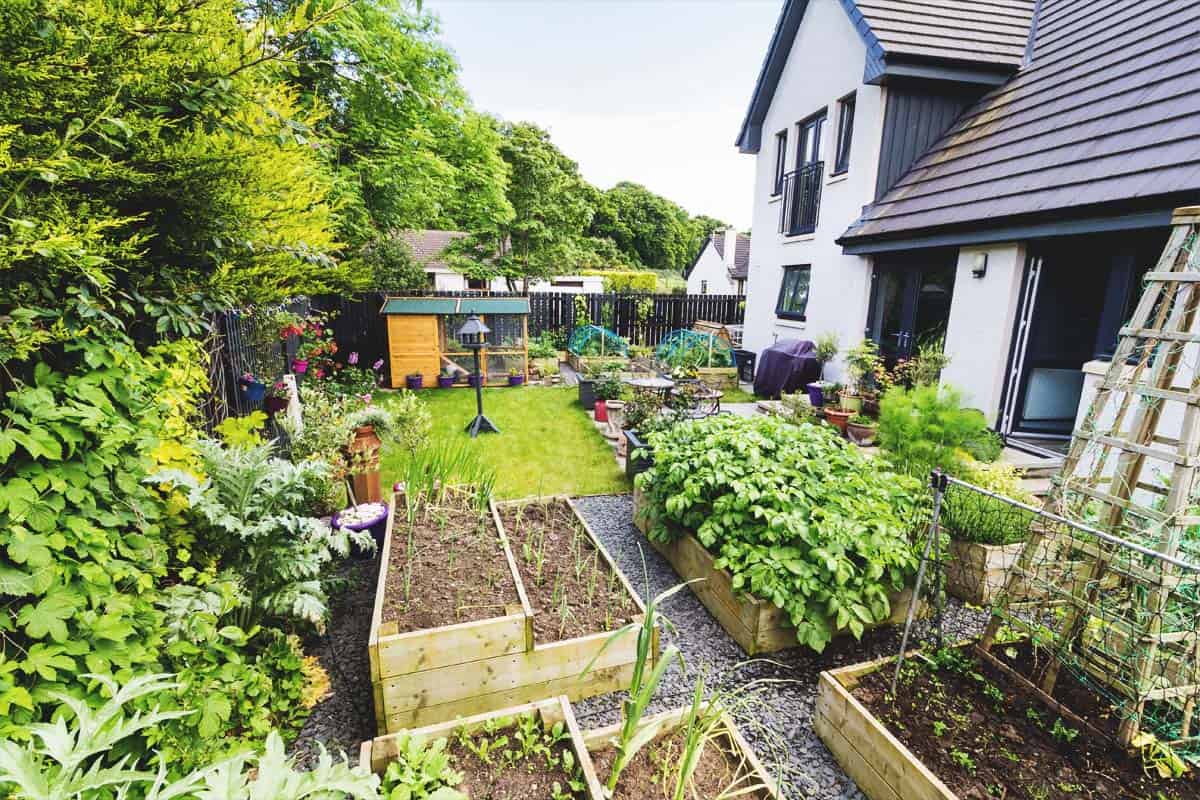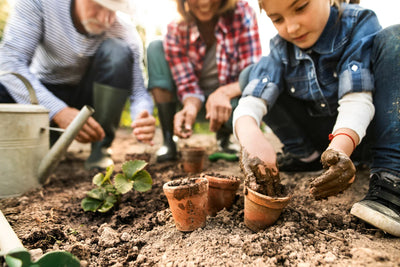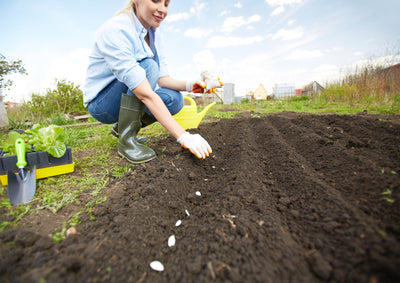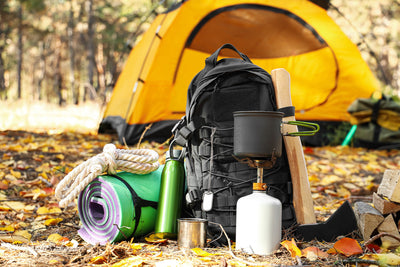Homesteading first came into the mainstream when The Homesteading Act of 1862 was enacted to spark more settlement in the West through free farmland. Today, the word is still used to describe self-sufficiency through homestead gardening, maximizing your own resources, and depending less on others.
You can take those first steps into homesteading through gardening and raising small animals on your land. Here's a round-up of how to get started, what to know, and how to flourish.
How Big Should a Homestead Garden Be?
There's no set rule about how big a homestead garden should be, but you should aim for about 200 square feet of garden space per person for a year-round harvest that feeds everyone. So a family of four should plan for about 800 square feet of garden in a plot that's 20 feet by 40 feet.
Beyond your homestead garden, you should also consider whether or not you want to raise chickens, goats, and other small farm animals. You'll need to consider where to place and fortify your garden to ensure it stays intact while benefiting your livestock. Some animals, like chickens, could also help your garden by controlling your slug and worm population.
Choose High-Yield Plants
The goal of homestead gardening is to create enough sustainable food and resources for you and your family. It makes sense trying to garden small-yield fruits and vegetables probably isn't the best use of your time and resources, at least when you're first starting out and learning how everything works.
High-yield crops and plants produce more food per square foot in your garden. They use up less space but still flourish with some care. Your climate and soil may dictate which crops produce the most yields. However, these crops are robust and grow well, even if you're new to homestead gardening:
- Tomatoes
- Beans
- Onions
- Sweet corn
- Lettuce
- Squash
- Zucchini
- Radishes
- Hot peppers
- Cucumbers
With the right crops and high-volume yield, you have plenty of fruits and vegetables to maximize your dietary needs and nutrition. Depending on what you grow, you can also consider pickling or canning your produce to preserve for future use.
Focus on Cultivating Healthy Soil
Creating nutrient-rich soil is a foundation for homestead gardening. Healthy soil usually contains a mixture of compost, peat moss, and vermiculite. It should also stay properly hydrated and have good sun with some shade during the day. Although some plants thrive in direct sunlight, many don't and will drag down your homesteading efforts before you ever get started.
Consider Companion Gardening
Companion gardening, or companion planting, is surprisingly beneficial to help your crops thrive. Tall plants can provide the necessary shade for shorter ones if you struggle with too much sunlight. You'll need to research your climate to determine which companion plants work well together. But as a general rule, beets, cabbage, carrots, cucumbers, and potatoes grow well alongside one another and produce healthy yields.
Rotate Your Crops
Crop rotation is an essential homestead gardening strategy that helps manage your soil and fertility. It can improve your soil's health and manage erosion when done correctly. Crop rotation is also sustainable and eliminates reliance on harsh fertilizers, pesticides, and herbicides.
The idea is to plant crops in different areas of the garden so that no single crop is planted in the same place for more than two consecutive years. When crops are rotated, they share their nutrients and improve soil quality. You'll still need some type of fertilizer. Although compost is not technically a fertilizer by commercial standards, most homestead gardeners consider it one as it enriches the soil.
Don't Forget About Herbal Medicine
Herbs have long been used for medicinal purposes, especially during trying times. Choose options like German Chamomile that help promote wound healing, reduce muscle spasms, and help promote better sleep. Here are some of the herbs to consider for your homestead gardening plans:
Achillea - Golden Yarrow
Achillea - Turn to Golden Yarrow to treat anything from eczema to irritable bowel syndrome and to heal minor wounds.
White Yarrow
Use White Yarrow for fever, common cold, hay fever, diarrhea, GI tract discomfort, and loss of appetite.
Anise - Pimpinella Anisum
Use Anise as a cough expectorant to treat upset stomachs, stimulate appetite, and a diuretic to increase urine flow.
Echinacea - Purple Coneflower
Treat common colds, coughs, bronchitis, upper respiratory infections, and some inflammatory conditions.
Fennel - Florence
Fennel helps produce an anti-inflammatory response and can be used as a laxative and diuretic.
Lavender - English
Lavender is used to help treat headaches and exhaustion and promote relaxation. Some herbalists also use lavender to treat minor wounds, acne, and fungal infections.
St. John's Wort
St. John's Wort is often taken in liquid or capsule form or added to tea as a dried herb. People have used it for centuries to treat mild to moderate depression.
Create a Seed Vault
A seed vault is part of a survival gardener's strategy but is also wise when homesteading. When your goal is self-sufficiency, you want to make sure you have enough seeds to carry you through a crisis and remain sustainable for as long as possible.
You can choose from a small rapid-grow vault with dozens of essential seed varieties, including beans, collard greens, spinach, tomatoes, and radishes. Or pick a Survival Vault Super Kit, providing nearly 28,000 usable seeds and comes with a growing guide, waterproof packaging, labels, and recipes. Whatever vault you create, remember to continuously save and store your new seeds to develop a sustainable, ongoing food source.
Maintain Your Garden
Good homestead gardening maintenance is key to your long-term sustainability. Make regular weeding, watering, and seed gathering a standard practice. You can also help prevent weeds in the first place by mulching your soil.
Organic matter, including wood chips, grass clippings, leaves, peat moss, and sawdust, are also popular choices for natural homestead gardening coverage. It helps keep weeds at bay while maintaining good soil temperature and structure. When weeds do try to grow, they end up smothered in your mulch and stop them from spreading.
You can also turn to drip irrigation to supply water to specific sections of your homestead garden instead of nourishing the weeds in the surrounding regions. A system of strategic hose placement also helps amplify your homestead gardening efforts. Connecting tees for your hoses helps create branches to other parts of your homestead, up hills, and in challenging-to-water areas.
Take Notes
Part of successful homestead gardening is taking notes and making observations. Jot down which plants worked and how you planted them. Are they next to each other? Did you rely on a specific type of organic fertilizer, like compost? You should also note the overall weather and rain conditions to determine what impacted your efforts.
Review your notes when it's time to plant crops again and update your old ones. You may discover a specific crop only grows well at the end of a season. The more you can monitor what's going on in your garden and look for clues to why it's happening, the easier it is to avoid failures and replicate your successes.
Slowly Expand Your Homestead Gardening Skills
Learning homestead gardening doesn't happen overnight. It's a process largely learned through getting your hands dirty and learning. Start small and focus on mastering the basics with some simple, durable crops like carrots or potatoes. As you figure out what works and what doesn't, you expand your garden and look to more challenging crops.
Beyond homestead gardening, you'll also learn what foods are worth your while. Harvesting cucumbers and beets is usually easy, but you may decide watermelon gives you too much grief. Remember, what works for one gardener may not work for you or vice versa. Your climate and soil conditions will largely shape whether or not your homestead gardening flourishes.
Don't Give Up
Even the most skilled homestead gardeners stumble and see crops fail. You'll never have a 100% success rate in your garden, but the point of homesteading is sustainability and becoming self-reliant. When you face obstacles, you learn to work through them and find resourceful ways to cope. After all, the real essence of homesteading is about perseverance.
Next Steps
Homestead gardening is worth exploring if you're interested in living a more sustainable life. You can start it as a hobby and enjoy your harvest, or take a more survivalist approach that sustains you and your family through hard times.
Ready to get started building your own seed vault for your homestead? We provide a one-stop shopping experience for your survival gardening needs. Browse our survival seeds, kits, and supplies, or purchase our pre-packaged options.






